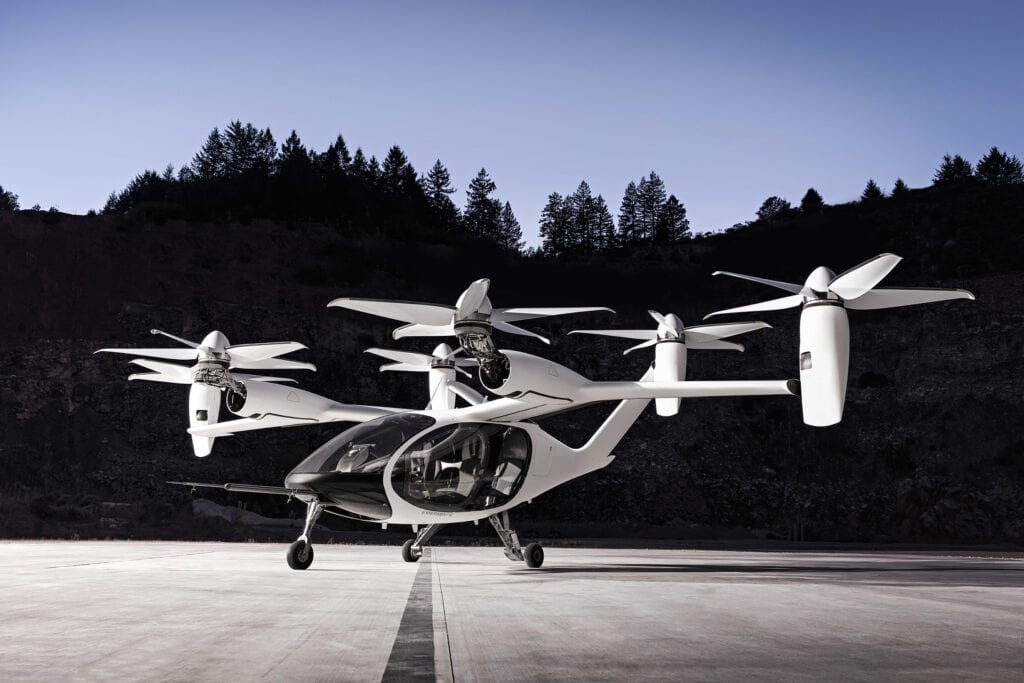
Joby Aviation received the first military airworthiness for an electric vertical take-off and landing (eVTOL) vehicle from the AFWERX Agility Prime program. (Joby Aviation)
If the military were to conduct a mission in response to a hurricane on an island nation, it has to consider the logistics of what equipment it can bring with them. The first step to doing this is often sling loading a team of eight people, two humvees, two ATVs, and about 5,000 pounds of equipment into a location to assess the capacity of its airfield. And once they complete an assessment and move equipment to the base, they have to send large trucks to carry supplies to distribution nodes. While this process has been effective in the past, it’s often not efficient.
If the military used orbs for these missions, they could transport the team around the field to conduct an operations assessment and then exfiltrate them back to the main operating base without having to sling load the team and equipment, Lt. Col. Shane Hughes, 621st Contingency Response Wing USAF, explained during an AFWERX Accelerate panel. Once the airfield is established, the orbs could then be used to set up distribution points at greater and more remote distances than trucks could traditionally reach.
Orbs, which are essentially electric vertical takeoff and landing (eVTOL) aircraft, are novel in how they operate and the technology they use presents the military with new use cases for old problems. Orbs can be manned or unmanned and incorporate non-traditional electric or hybrid propulsion. During a virtual panel hosted by AFWERX Accelerate, military leaders discussed how orbs could be used in future contingency response and personnel recovery missions.
“There are times where I really wish I had some options, right, some more volume, some extra kind of hip pocket strategies to enhance that mission and one of the things we’re looking at is, you know, the replacing of different things but also the enhancing and extending of current capabilities,” Lt. Col. Martin Salinas, mission design lead USAF, said.
The Air Force is shifting its operating concept to meet the demands of great power competition which involves moving sustained forces under attack, Col. Peter White, Commander 563D rescue group USAF, said. To do this, the Air Force needs to be leaner and lighter but they are facing challenges with oil requirements, personnel to maintain complicated aircraft, spare parts, and coverage areas. White says all of these can be overcome using orbs.
“We need the ability to spoke out of a hub and to get as far forward on the battlespace as possible to provide responsive CSAR coverage for our fighter bomber,” White said. “So orbs, like I said, can really really help mitigate some of these problems. I see that obviously with low POL [petroleum, oil, lubricants] and parts requirements, solid-state technology, all this well to reduce the number of personnel needed to maintain aircraft, as well as the size of the CSAR spoke that we would put forward on in the battlespace.”
Using orbs could also come at a lower price point which could increase the size of the CSAR force, White said. Current CSAR operations are limited by the number of personnel required and the time it takes them to relocate.
“What does that look like to me, its orb CSAR spokes forward and across the battlespace that are operating with five to ten maintainers and operators total in small geographic locations that are able to pick up and move within hours of being tasked to new locations,” White said. “That’s drastically different from our current construct with limited numbers. CSAR spokes, roughly 30 ish possibly more operators and maintainers, in locations that take hours to move, or I should say I’m sorry days to move, to geographically limited areas. So again that operational kind of moving the chess pieces on the board I think orbs can play a big part in providing us the agility required.”
LCDR Bill Haywood, UAS program manager for the U.S. Coast Guard (USCG) office of aviation forces, said orbs could be used to supplement search and rescue missions by dropping gear to survivors, monitoring a scene, or operating as an airborne communications platform.
“To supplement using these orbs for short-range search and rescue, dropping gear to survivors until another asset can come and recover them whether it be a boat or a helicopter, they can get out there on scene monitoring, even just staying airborne for a comms platform, which we’ll launch a fixed-wing asset to go overhead just so we can talk to home base and if you can take that out of the equation, just the amount of money per flight cost to have a C-130 overhead, just so you can talk, that’s not very efficient. If you could have an orb doing that would be fantastic,” Haywood said.
When developing orbs, the military and industry are focusing on a DevOps model, Capt. Terrence McKenna, 370th Flight Test Squadron, said. This means bringing in operators early in the development phase to create an open communications line to facilitate use cases. They are also conducting experiments backed up by in-depth analysis.
“Those experiments help us assess possible use cases for existing tech without deriving explicit requirements at the outset so a different take on kind of a traditional acquisitions model that we’re all used to,” McKenna said.